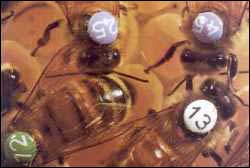NSF Announces Six "FIBR" Awards To Tackle Some Of Biology’s Most Challenging Questions

Tagged bees communicating on hive honeycomb. Through a functional analysis of social behavior in honey bees across the entire genome, the BeeSpace project will tackle one of the most hotly debated questions in biology: Are genes or environment the primary reason for a person’s or other animal’s behavior? Credit: Copyright Ken Lorenzen, University of California, Davis
Multidisciplinary teams to study animal movement, genetic links to outside world
How exactly do animals move? How do organisms adapt to newly acquired genes? What genetic forces draw members of an ecological community together? And does social behavior originate in nature, nurture or both? To tackle these and other major questions in biology, the National Science Foundation (NSF) today announced six new awards totaling nearly $30 million over five years from its Frontiers in Integrative Biological Research (FIBR) program.
Each of the five-year awards brings together scientists from many areas of biology and other fields to draw upon advances in genomics, ecology, enhanced information technology, and other fields — not to mention a robotic cockroach — to address significant under-studied or unanswered questions in biology.
“FIBR is one of the premier, crosscutting programs in biology at NSF,” said Mary Clutter, head of NSF’s Biological Sciences directorate. “By undertaking highly innovative and broadly integrative approaches to research in biology, FIBR projects tackle grand challenges and promote the training of a new and fearless generation of scientists willing and able to bridge conventional disciplinary boundaries.”
Several of this year’s FIBR awards will focus on the relationship between an organism’s genes and the outside world. One project will examine how a plant evaluates the various cues of seasonal change so that it blooms when it has the best chance to reproduce successfully. A second project will try to unravel “ecological genomics,” identifying the genetic linkages that draw species together into complex communities and whole ecosystems.
Genes and environment both contribute to behavior, and another project will tackle the hotly debated nature or nurture question by analyzing social behavior as it relates to an entire genome — that of the honey bee.
Scientists now know that up to a quarter of all genes in many organisms are acquired from completely unrelated species, and a fourth FIBR project will study the processes by which organisms adapt to these newly acquired genes.
To explain the complex signals and feedbacks among neurons, muscles, the skeleton and the whole body that make movement possible and prevent animals from falling over, another project will take a multidisciplinary approach to the study of live, simulated and robotic insects. The sixth FIBR project will undertake a study of photosynthesis to understand how large and complex networks of molecules arise, persist and evolve as modular units throughout biology.
The six FIBR projects integrate varied expertise from several universities and research institutes. Combined, the six projects support dozens of investigators from 15 U.S. states and also involve scientists supported by several other countries.
The FIBR projects announced today include the following (see separate profiles for more detail):
“BeeSpace: An Interactive Environment for Analyzing Nature and Nurture in Societal Roles,” examining how much of social behavior is determined by genes and how much is influenced by the environment — University of Illinois, Urbana-Champaign
“Ecological Genomics and Heritability: Consequences of Extended Phenotypes,” studying the genetic forces that draw together members of an ecological community — Northern Arizona University (lead), University of Wisconsin, University of Tennessee, University of Tasmania (Australia)
“How Organisms Adapt to New Enzymes and New Pathways,” understanding how organisms adapt to opportunities for rapid evolution through newly acquired genes — Brandeis University (lead), Boston University, University of Michigan
“Molecular Evolutionary Ecology of Developmental Signaling Pathways in Complex Environments,” examining how plants weigh the various cues of seasonal change to make timing choices that are right for their climate — Brown University (lead), University of Wisconsin, North Carolina State University, Kansas State University, Max Planck Institute for Developmental Biology (Germany)
“Neuromechanical Systems Biology,” studying the complex signals and feedbacks among neurons, muscles, the skeleton and the whole body that make movement possible — University of California, Berkeley (lead), Montana State University, University of Michigan, Cornell University, Princeton University
“A Systems Approach to Study Redox Regulation of Functions of Photosynthetic Organisms,” studying how whole molecular networks may serve as modular units for function, regulation and evolution — Washington University, St. Louis (lead), Colgate University, Pacific Northwest National Laboratory, Saitama University (Japan)
Separate profiles below provide more details on each of the awards, along with principal investigators, team members and university media contacts.
Media Contact
All latest news from the category: Life Sciences and Chemistry
Articles and reports from the Life Sciences and chemistry area deal with applied and basic research into modern biology, chemistry and human medicine.
Valuable information can be found on a range of life sciences fields including bacteriology, biochemistry, bionics, bioinformatics, biophysics, biotechnology, genetics, geobotany, human biology, marine biology, microbiology, molecular biology, cellular biology, zoology, bioinorganic chemistry, microchemistry and environmental chemistry.
Newest articles

Properties of new materials for microchips
… can now be measured well. Reseachers of Delft University of Technology demonstrated measuring performance properties of ultrathin silicon membranes. Making ever smaller and more powerful chips requires new ultrathin…

Floating solar’s potential
… to support sustainable development by addressing climate, water, and energy goals holistically. A new study published this week in Nature Energy raises the potential for floating solar photovoltaics (FPV)…

Skyrmions move at record speeds
… a step towards the computing of the future. An international research team led by scientists from the CNRS1 has discovered that the magnetic nanobubbles2 known as skyrmions can be…





















